View in other NatureServe Network Field Guides
NatureServe
Montana
Utah
Wyoming
Idaho
Wisconsin
British Columbia
South Carolina
Yukon
California
New York
Ute Ladies'-tresses - Spiranthes diluvialis
Other Names:
Ute Lady's-tresses, Ute Ladies-tresses
State Rank Reason (see State Rank above)
Spiranthes diluvialis is known from a small number of occurrences in southwest and south-central Montana. Plants occur in the valleys of the Missouri, Jefferson, Beaverhead, Ruby, and Madison River drainages where it is restricted in area by specific hydrologic requirements. Many populations have less than 100 individuals, though a couple have over 500 plants. Sites are susceptible to hydrologic changes and weed invasion. Large areas of habitat have been converted to agricultural uses. Agricultural practices can hinder or promote plants depending upon their timing with critical reproductive stages. A few populations occur along highway right-of-ways. Most populations occur on private lands and only one occurrence is currently provided some potential protection or management for its conservation value.
- Details on Status Ranking and Review
Population Size
Score2 - Small: Generally 2,000-10,000 individuals.
Range Extent
Score2 - Regional or State Endemic or Small Montana Range: Generally restricted to an area <100,000 sq. miles (equivalent to 2/3 the size of Montana or less) or Montana contributes 50% or more of the species’ range or populations OR limited to 2-3 Sub-basins in Montana.
CommentGlobal distribution consists of several discontiguous areas.
Area of Occupancy
Score1-2 - Low to Moderate. Occurs in 4-25 Subwatersheds (6th Code HUC’s), though the species' distribution is not sufficiently documented to place it within one class.
CommentOccurred historically in over 10 subwatersheds, but it is unclear if a few of the sites are still extant.
Environmental Specificity
Score2 - High: Species is restricted to a highly specialized and limited habitat and is typically dependent upon unaltered, high-quality habitat (C Values of 8-10).
Trends
Score2-3 - Moderate to Severe Declines:
CommentThough actual trends are unknown, much suitable habitat has been lost or degraded.
Threats
Score2-3 - High to Very High.
CommentInvasive weeds, hydrologic alterations, development and agricultural conversion are the primary threats. Much of its floodplain habitat remains threatened by one or more of these threats.
Intrinsic Vulnerability
Score2 - High Vulnerability: Very specific biological attributes, unusual life history characteristics or limited reproductive potential makes the species highly susceptible to extirpation from stochastic events or other adverse impacts to its habitat and very slow to recover.
Raw Conservation Status Score
Score
13 to 16 total points scored out of a possible 19.
General Description
PLANTS: A long-lived perennial plant, usually with a single stem, 3-20(-40) cm tall, that grows from a thickened, tuberous root. Source: Lesica et al. 2012.
LEAVES: Narrow, linear leaves about 1 cm wide and up to 20 cm long. Leaves are longest at their base, becoming shorter towards the inflorescence, and persist during flowering. Source: Lesica et al. 2012.
INFLORESCENCE: A terminal bracteate spike that is glandular-puberulent, 2-8 cm long. Few to many, white or ivory flowers spiral around the upper stem, in a 3-rank pattern. Bracts are 6-12 cm long. Flowers are perpendicular to the stem, 6-merous, but there is merger in each of the uppermost petals or sepals and lowermost petals or sepals. Upper, lower, and lateral sepals are greenish. Upper sepals and upper petals are crowded together, united below, and form a forward-pointing hood. Lateral sepals are separate or may be slightly connate at their base and often spread abruptly apart. Lip petal is 6-9 mm long, tongue-shaped yet narrowed at the middle, points downward, is wavy-margined, and is blunt at the tip. Hood formed by petals and sepals is 7-12 mm long. Source: Lesica et al. 2012.
The genus
Spiranthes comes from the Greek words of "speira" which means coiled and "anthos" which means flower. They refer to the spirally arranged inflorescence. Charles Sheviak described the species and chose the specific epithet of "
diluvialis", which comes from the word "diluvium" meaning "flood"; it refers to the species' moist habitat that temporarily floods in what is otherwise an arid environment (Sheviak 1984).
The common name of "Ladies'-tresses" refers to the inflorescence which resembles the braided locks of hair worn by women (USFWS 1990). The common name of "Ute" was given by the USFWS to recognize that the plant's historic range was largely used by the Ute Indian Tribe (USFWS 1990).
NATIONAL LINK - IDENTIFICATIONGo Orchids-North American Orchid Conservation Center
Phenology
Ute Ladies'-tresses flowers from July to early September across its range (Sheviak and Brown in Flora of North America (FNA)). In Montana flowering typically occurs in August to early September, but often is not in full flower until mid-August.
Diagnostic Characteristics
Ute Ladies'-tresses was first collected in Colorado in 1856 and in Utah in 1880. However, it was not recognized as a unique species until 1984 when Charles Sheviak realized it represented a suite of different morphological characteristics (Sheviak 1984).
Ute Ladies'-tresses -
Spiranthes diluvialis, Federally Threatened, SOC
*Inflorescence: Flowers in the spike are spaced further apart, less dense. Flowers spiral on the spike creating 3-ranks or columns.
*Upper Sepals/Petals: Form a less distinct hood and are more long and slender. Both are separated for most of their length, connecting only at their base. Hood is 7-12 mm long.
*Lip Petal: Clearly visible when viewed from the side. Petal is not constricted in the middle and has a blunt tip. Spur is absent.
*Habitat: Wet, calcareous, riparian meadows in valleys.
Hooded Ladies'-tresses -
Spiranthes romanzoffiana*Flowers: Flowers in spike are densely crowded. Flowers spiral on the spike creating 3- or 4- ranks or columns. Flowers grow more upright.
*Upper Sepals/Petals: Sepals are partially fused and united with the petals, forming a true hood over the stamens and pistil. Hood is shorter, 5-10 mm long.
*Lip Petal: Partially hidden by the hood, making it difficult to see when viewed from the side. Petal is constricted in the middle, like a violin, and has an acute tip. Spur is absent.
*Habitat: Wet meadows, fens, and occasionally in grasslands, from valleys to subalpine.
Bog Orchids -
Platanthera species
*Flowers: Arranged in a spike-like raceme, but do not spiral around the stalk.
*Lip petal: Forms a downward pointing spur.
*Leaves: Either basal or leafy along entire stem. Those on the stem are sheathing, alternately-arranged, and whither during flowering.
Rein Orchids -
Piperia species
*Flowers: Arranged in a spike-like raceme, but do not spiral around the stalk.
*Lip petal: Forms a downward pointing spur.
*Leaves: Basal and on the lower third of the stem. Those on the stem are sheathing and may be arranged opposite or alternate.
Species Range
Montana Range
Range Descriptions
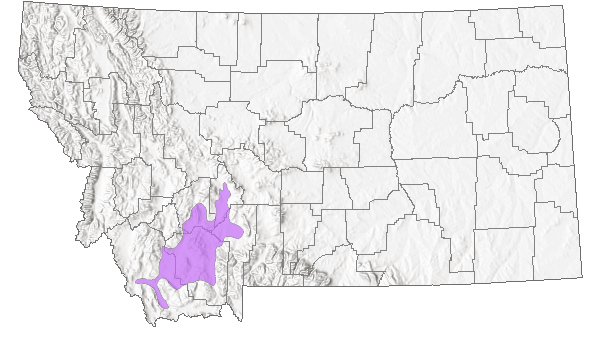
 Native
Native
Range Comments
Ute Ladies'-tresses is endemic to the United States, occurring in the interior west where it is sparse and highly restricted on the landscape (Fertig et al. 2005):
*Colorado: central, north-central, northwest
*Idaho: eastern
*Montana: southwest, south-central
*Nebraska: western
*Nevada: southeastern
*Utah: south-central, northern
*Washington: north-central
*Wyoming: southeast
In Montana, Ute Ladies'-tresses was discovered by the MTNHP Botanist on August 3, 1994 at Piedmont Swamp in Jefferson County. Since then plants have been found in the valleys of the Beaverhead, Lower Gallatin, Lower and Upper Jefferson, Upper Missouri, and Ruby River drainages. The majority of sites occur on private land with a minority occurring on land under State or mixed ownership. Distribution modelling by the MTNHP indicates that southwest and south-central Montana may have more suitable habitat which has not been surveyed (refer to the Habitat section).
Observations in Montana Natural Heritage Program Database
Number of Observations: 561
(Click on the following maps and charts to see full sized version)
Map Help and Descriptions
Relative Density
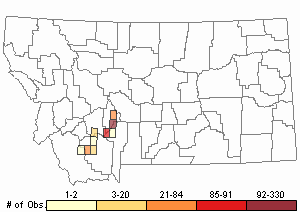
Recency
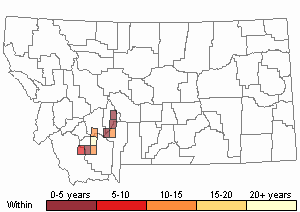

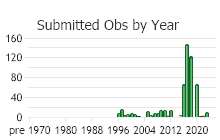
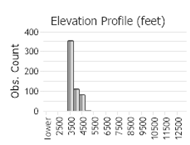 (Observations spanning multiple months or years are excluded from time charts)
(Observations spanning multiple months or years are excluded from time charts)
Habitat
In Montana plants grow in calcareous wetlands, swales, and old meander channels that are outside of the active stream channel (Heidel 2001; Lesica et al. 2012). Within these habitats plants often grow at the wetland edges or in areas that dry by mid-summer. Plants can occupy small, fragmented parcels of habitat.
Populations are maintained by conditions that maintain an early-seral habitat stage. These conditions could include alkaline or calcareous soils, seasonal flooding, and grazing.
Ecological Systems Associated with this Species
Ecology
In sites with an open canopy plants flower earlier while in well-shaded sites plants flower later (Jennings 1989).
POLLINATION [Adapted from Fertig et al. 2005]
Flowers of Ute Ladies-tresses are primarily pollinated by solitary bees (
Anthophora spp.) and bumble bees (
Bombus spp.), and sometimes by non-native honey bees (
Apis mellifera).
Bombus fervidus has been reported as a pollinator where its geographical distribution overlaps with
Spiranthes (Colla and Dumesh 2010). Several studies in Utah concluded that orchids pollinated by
Anthophora terminalis produce three times as many fruits as plants pollinated by
Bombus species. Many long-term studies of pollinators have found that the abundance and composition of the bee fauna vary in any given year. Syrphid flies, skippers, and other hymenopteran insects have been observed on flowers of Ute Ladies'-tresses, but are thought to be either too small or improperly shaped to function as effective pollinators.
Within the inflorescence, the lower-most flowers open and mature before those that are higher up on the stalk. Each flower contains 1-2 stamens (male) and 1 pistil (female). The pollen-bearing anthers of the stamens mature before the stigma of the pistil is receptive. Thus, when a bee visits, the flowers are essentially unisexual, passing through a staminate stage before becoming pistillate. As flowers mature along the inflorescence those higher up on the stalk are staminate while those below are pistillate. Lured by a visual cue, bees visit the lowermost flowers first before proceeding up the stalk. Since the upper flowers are not receptive to the pollen (i.e., stigma is not yet sticky to catch pollen), pollen remains on the bee's back until if flies to a different inflorescence where it pollinates a receptive stigma on the pistil, and continues its foraging strategy.
The asynchronous maturation of flowers within an inflorescence promotes cross-pollination (outcrossing) between individual plants. However, staminate and pistillate stages may overlap in the same inflorescence, resulting in pollen from one flower fertilizing eggs in the pistil of another flower on the same plant. It is hypothesized that Ute Ladies'-tresses may be capable of agamospermy, which is a form of asexual reproduction in which seeds are produced without fertilization.
Reproductive Characteristics
Plants are long-lived herbaceous, perennials that likely reproduce only by seed (Fertig et al. 2005). Occasionally plants are found to grow in clusters, but these are thought to result from either asexual reproduction from a single or broken root mass or germination from an entire capsule where multiple seeds germinated (Fertig et al. 2005).
FLOWERS
Stamens: 1 or 2, fertile, and unite with the style of the pistil to form a column (Lesica et al. 2012). Pistil: 1 style and a 3-celled, inferior ovary.
Flowers have a vanilla-like scent (Fertig et al. 2005). Within the spike, the lower-most flowers bloom first.
FRUITS
An ovoid capsule, 10-15 mm long that opens longitudinally to expose many seeds (Lesica et al. 2012; Fertig et al. 2005).
LIFE CYCLE [Adapted from Fertig et al. 2005]
Over a lifetime, individual Ute Ladies'-tresses exhibit four main stages which occur in no particular order or for any particular length of time: seedling, dormant, vegetative, and reproductive. The life cycle is charted in Fertig et al. (2005). In most years, a portion of a population will exhibit dormancy, while others will flower, and the remainder will be in a vegetative stage. The relative proportion of plants in each life stage will vary by year and between populations. Life stages may be triggered or suppressed in response to grazing, pollinator success, climate, habitat disturbance, and management practices. Refer to the MANAGEMENT section.
Fruiting and Seed Development
Across its range, fruits (capsules) are produced from late August to September and seeds are shed shortly after. Orchids are known to have microscopic, dust-like seeds that easily disperse by wind or water, and the seeds of Ute Ladies'-tresses are no exception. Capsules may contain from several hundred to several thousand seeds, and a single plant could produce 100,000 seeds in a year. Their tiny size indicates that seeds contain very little stored food which is required to sustain the embryo; therefore, seeds are likely very short-lived once they contact the soil. At the Cincinnati Zoo and Botanical Garden in Ohio, seeds of Ute Ladies'-tresses were cultured in the lab but took 1.5 years for germination to occur. In the natural world, it is hypothesized that germinated seedlings must quickly establish a symbiotic relationship with soil-dwelling mycorrhizal fungi in order to survive. The absence or presence of appropriate mycorrhizal fungi in the soil may limit population sizes. Seedlings may persist for up to 8 years as subterranean saprophytes dependent on mycorrhizal fungi (Heidel 1998). Other Spiranthes species have shown they can remain dormant for 8 to 11 years (Wells 1981).
Subterranean Dormant Stage
It is unknown at what age germinated plants must be in order to develop above-ground leafy shoots. At some age, possibly 8 to 11 years, plants emerge above the ground. Long-term demographic monitoring of Ute Ladies'-tresses demonstrated that vegetative or reproductive individuals can re-vert to a below ground dormant stage for 1 to 4 years, or longer, before re-emerging above ground. Although plants are considered to be dormant, subterranean plants remain metabolically active and derive nourishment from their mycorrhizal partners or food stores laid down when photosynthetic shoots were present.
Vegetative Stage
Vegetative shoots develop in October and persist through winter as small rosettes. In the spring growth resumes, developing into short-stemmed, leafy, photosynthetic plants. They remain vegetative or they may develop an inflorescence, depending upon the site's productivity and conditions. Come winter the vegetative shoot dies back to subterranean roots and leaves persist as a winter rosette. Demographic monitoring demonstrates that vegetative plants can remain in this stage for 2 or more years or can transform to a dormant subterranean stage or can become reproductive in subsequent years.
Reproductive Stage
Across its range Ute Ladies'-tresses blooms from early July to late October. Life expectancy is estimated at more than 50 years based on a related Spiranthes species (Heidel 1998).
Refer to the ECOLOGY / POLLINATION section.
SPECIES ORIGINATION
It is hypothesized that during the Pleistocene epoch Spiranthes diluvialis arose as a hybrid between Spiranthes romanzoffiana and Spiranthes magnicarporum (Sheviak 1984); Spiranthes magnicarporum is not known from Montana. Spiranthes diluvialis is intermediate in its morphology between these putative progenitors. Hybridization resulted in an allopolyploid species (Spiranthes diluvialis). Allopolyploid species have a complete diploid set of chromosomes from each genetically distinct parent. It is the doubling of chromosomes in the hybrid that allows it to be fertile, but no longer cross-compatible with its parent species. As the climate during the Pleistocene became drier, these three plants responded by occupying different habitats:
*Spiranthes romanzoffiana retreated to higher, cooler, and wetter sites; today it is globally widespread, with a tendency to be found at northern latitudes or at higher elevations.
*Spiranthes magnicarporum retreated to warm, mesic sites; today it is a plains plant found in moist areas of the Midwest and east.
*Spiranthes diluvialis persisted in warm, wet sites. As the climate became more arid, Spiranthes diluvialis' habitat became more limited.
Management
ENDANGERED SPECIES ACTRecognizing that America's rich natural heritage is of esthetic, ecological, educational, recreational, and scientific values to our Nation and its people, the Endangered Species Act (ESA) was created to recover and protect imperiled species. The ESA of 1973 as amended by Congress provides for the conservation of endangered and threatened species of fish, wildlife, and plants, and for other purposes. The ESA mostly requires the U.S. Fish and Wildlife Service (USFWS) to: a) list, classify, protect, and recover species [Sections 4, 9, and 12], b) review and evaluate federal actions for potential affects to listed species [Section 7], c) oversee recovery activities [Sections 4, 5, and 6]; d) work cooperatively with the States [Section 6] and internationally [Section 8]; and e) provide exemptions (permits) for scientific efforts and conservation activities [Section 10]. The USFWS uses five main factors to determine if a proposed species warrants listing under the ESA: 1) present or threatened habitat/range loss, 2) overutilization, 3) disease/predation, 4) inadequacy of protections, and 5) other threats. The de-listing of a species is assessed using three criteria: 1) recovery, 2) extinction, or 3) erroneous information at the time of listing. The USFWS uses a Species Status Assessment to evaluate the resiliency, redundancy, and representation to understand the current and potential future viability of a species to inform listing, consultation, and recovery decisions (USFWS 2016;
USFWS Species Status Assessment).
Ute Ladies'-tresses under the ESAUte Ladies'-tresses was listed as Threatened under the ESA on January 17, 1992 (USFWS 1992). Designated by the USFWS, Threatened Species are "any species which is
likely to become an endangered species within the
foreseeable future throughout all or a significant portion of its range.
Ute Ladies'-tresses was listed as threatened because of habitat loss and modification, and the understanding that its small populations and low reproductive rates make it vulnerable to other threats (USFWS 1992). Specifically, habitat loss and modification were reported based on loss of riparian habitat, urban residential development, stream channelization, and construction projects (USFWS 1992). In addition, there were concerns that this plant could be over-collected by orchid enthusiasts and gardeners (USFWS 1992). At the time of listing, it was known only from north-central Colorado, south-central Utah, and southeastern Nevada. Since its listing surveys have found it in 9 states (Fertig et al. 2005); refer to the RANGE COMMENTS section. In 1994 Montana's first population was discovered; refer to the RANGE COMMENTS section. Surveys have resulted in finding new populations across a larger range where it is usually sparse and highly restricted on the landscape.
In 1995 a draft recovery plan was prepared by the Ute Ladies'-tresses recovery team (USFWS 1995). In 1996 the Central Utah Water Conservancy District petitioned the USFWS to delist Ute Ladies'-tresses on the grounds that it was sufficiently widespread and secure enough that it no longer warranted protection under the ESA. In 2004 The USFWS published a 90-day Finding that determined the petition had sufficient information that a Status Review should be initiated to determine if de-listing would be warranted (USFWS 2004). In 2005 the Range-wide Status Review of Ute Ladies’-Tresses was prepared for the USFWS and Central Utah Water Conservancy District by Fertig, Black, and Wolken (2005). In 2017 the USFWS - Utah Field Office has begun the process to evaluate the status of Ute Ladies'-tresses. Funding from the USFWS and the State of Wyoming allowed the Wyoming Natural Diversity Database to develop a Predictive Distribution Model based on range-wide occurrence data.
In June 2023, the USFWS completed a species status assessment (SSA) on Ute Ladies'-tresses and issued a report (USFWS 2023a). The SSA uses the conservation biology principles of resiliency, redundancy, and representation as a lens to evaluate the current and future condition of a species. In the SSA, Montana's populations occur in the Upper Missouri and Missouri Headwaters analytic units (AU). The Missouri Headwaters AU currently scored as being of high resiliency. Under three scenarios, projected future conditions based on climate change and anthropogenic activities for the Missouri Headwaters AU predicts a downward trend to a moderate or low resiliency. The Upper Missouri AU currently scored as being of moderate resiliency. Under 3 scenarios, projected future conditions based on climate change and anthropogenic activities for the Upper Missouri AU predicts a stable moderate trend or a downward trend to low resiliency. Readers are encouraged to consult the full SSA report (USFWS 2023a). In August 2023, the USFWS issued the 5-Year Status Review: Summary and Evaluation for Ute Ladies'-tresses (USFWS 2023b). Based on the information from the SSA report, the USFWS 5-Year Review is recommending that Ute Ladies'-tresses be delisted due to recovery (USFWS 2023b). However, the current classification of Threatened remains in place until there is a formal and official change in status.
Montana abides by federal Endangered Species regulations for listed plants as there is no state endangered law that specifically applies to vascular plants. Section 9 of the ESA regulates prohibitions. For threatened plants the following federal prohibitions apply:
* It is illegal to import or export (into, out of, or through the US) threatened plants.
* It is illegal to engage in interstate or foreign commerce with threatened plants.
* It is illegal to remove and reduce to possession threatened plants from Federal property (cultivated seeds excepted).
Other DesignationsThe Convention of the International Trade in Endangered Species (CITES) protects species from international trade and export. Ute Ladies'-tresses is listed in Appendix II of the CITES act.
CONSERVATIONAs part of the
Montana Native Plant Conservation Strategy: Species and Habitats of Concern, a specific conservation profile for Ute Ladies'-tresses is developed and can be found at:
North American Orchid Conservation Center website
Stewardship Responsibility
Threats or Limiting Factors
Across the range, current and potential long-term threats to Ute Ladies'-tresses includes habitat loss and modification (through urbanization, water development, and conversion of wetlands to agriculture), over-collection of plants, competition from exotic weeds, and herbicides (Fertig et al. 2005). In addition, plants are more susceptible to threats because their populations are usually small and their habitat is limited in the landscape and often fragmented.
Urbanization: Surviving populations within urban/suburban environments are more susceptible to extirpation because of increased recreational demands, changes in hydrology from flood control projects and road construction, competition from introduced weeds, and loss of native pollinators (Riedel 2002).
Road and Infrastructure Construction: Roads and structures built within Ute Ladies'-tresses habitat will directly disturb habitat and plants, and will indirectly impact populations by contributing to changes in hydrology (flooding or dewatering sites), favoring the establishment of competing weeds, create additional population fragmentation, and increase pollution runoff.
Recreation: Recreational activities can directly disturb habitat and plants. In Colorado the construction of hiking and biking trails is a threat to several populations. In Idaho, trampling and boat camping at fishing access sites has been reported as a potential threat. Also in Idaho, unauthorized off-road highway vehicle use is a potential threat.
Haying/Mowing is a threat to populations if not timed correctly. Mowing just before or during flowering can greatly reduce fruit production (Arft 1995).
Livestock Grazing is a threat to populations if not timed correctly. Ute Ladies'-tresses is edible to livestock. A reduction in flower and fruit production has been observed at sites that are grazed or trampled in the summer (Arft 1995, Fertig 2000, Murphy 2001).
STATE THREAT SCORE REASON
Reported threats to Montana's populations of Ute Ladies’-tresses focus primarily on potential impacts to the ephemeral wetland habitat for which it depends upon (MTNHP Threat Assessment 2021). Populations are found at the edges of wetlands, wet meadows, swales, and old meander channels that are outside of active stream channels. These habitats occur within land used for agriculture, ranching, and urban development/infrastructure and are prone to land use changes, livestock grazing, road construction and maintenance, and water management actions that modify seasonal hydrology. Reported threats inflicting direct stress are competition from invasive non-native species, urban development, damage from recreational use of off-highway vehicles (OHVs), and road construction. The risk of herbicide application and related decline in habitat quality is a concern as many populations exist on roadsides where herbicide is a common form of weed control. Certain agricultural and livestock grazing practices can be a threat if not managed or timed appropriately with Ute Ladies'-tresses' flowering and fruiting periods.
References
- Literature Cited AboveLegend:
 View Online Publication
View Online Publication Allison, T.D. 2001. Spiranthes diluvialis: An Evaluation of Treatment Effects and Survey Results. Report prepared for the City of Boulder Department of Open Spaces and Mountain Parks.
Allison, T.D. 2001. Spiranthes diluvialis: An Evaluation of Treatment Effects and Survey Results. Report prepared for the City of Boulder Department of Open Spaces and Mountain Parks. Arft, A.M. 1995. The genetics, demography, and conservation management of the rare orchid Spiranthes diluvialis. Ph.D. dissertation. University of Colorado, Boulder. 170 pp.
Arft, A.M. 1995. The genetics, demography, and conservation management of the rare orchid Spiranthes diluvialis. Ph.D. dissertation. University of Colorado, Boulder. 170 pp. Fertig, W. 2000. Status review of the Ute Ladies tresses (Spiranthes diluvialis) in Wyoming. Report prepared for the Wyoming Cooperative Fish and Wildlife Research Unit, US Fish and Wildlife Service, and Wyoming Game and Fish Department by the Wyoming Natural Diversity Database, Laramie, Wyoming.
Fertig, W. 2000. Status review of the Ute Ladies tresses (Spiranthes diluvialis) in Wyoming. Report prepared for the Wyoming Cooperative Fish and Wildlife Research Unit, US Fish and Wildlife Service, and Wyoming Game and Fish Department by the Wyoming Natural Diversity Database, Laramie, Wyoming. Fertig, Walter, Rick Black, and Paige Wolken. 2005. Rangewide Status Review of Ute Ladies'-Tresses (Spiranthes diluvialis). September 30th. Prepared for the U.S. Fish and Wildlife Service and Central Utah Water Conservancy District.
Fertig, Walter, Rick Black, and Paige Wolken. 2005. Rangewide Status Review of Ute Ladies'-Tresses (Spiranthes diluvialis). September 30th. Prepared for the U.S. Fish and Wildlife Service and Central Utah Water Conservancy District. Flora of North America Editorial Committee. 2002. Flora of North America North of Mexico. Vol. 26. Magnoliophyta: Liliidae: Liliales and Orchidales. New York, NY: Oxford Univ. Press. xxvi + 723 pp.
Flora of North America Editorial Committee. 2002. Flora of North America North of Mexico. Vol. 26. Magnoliophyta: Liliidae: Liliales and Orchidales. New York, NY: Oxford Univ. Press. xxvi + 723 pp. Hazlett, D.L. 1996. The Discovery of Spiranthes Diluvialis Along the Niobrara River in Wyoming and Nebraska. Unpublished Report to the Bureau of Land Management, Wyoming Office, Cheyenne, Wyoming. 16 Pp.
Hazlett, D.L. 1996. The Discovery of Spiranthes Diluvialis Along the Niobrara River in Wyoming and Nebraska. Unpublished Report to the Bureau of Land Management, Wyoming Office, Cheyenne, Wyoming. 16 Pp. Hazlett, D.L. 1997. A 1997 Search for Spiranthes Diluvialis in Southeastern Wyoming and Western Nebraska. Unpublished Report to the Bureau of Land Management, Wyoming State Office. Cheyenne, Wyoming. 12 Pp.
Hazlett, D.L. 1997. A 1997 Search for Spiranthes Diluvialis in Southeastern Wyoming and Western Nebraska. Unpublished Report to the Bureau of Land Management, Wyoming State Office. Cheyenne, Wyoming. 12 Pp. Heidel, B.L. 1998. Conservation status of Spiranthes diluvialis Sheviak in Montana. Unpublished report to U.S. Fish & Wildlife Service. Montana Natural Heritage Program, Helena, Montana. 55 pp. + appendices.
Heidel, B.L. 1998. Conservation status of Spiranthes diluvialis Sheviak in Montana. Unpublished report to U.S. Fish & Wildlife Service. Montana Natural Heritage Program, Helena, Montana. 55 pp. + appendices. Heidel, B.L. 2001. Monitoring Ute ladies'-tresses (Spiranthes diluvialis), in Jefferson County, Montana: final report, 1996-2000. Report to Bureau of Land Management. Montana Natural Heritage Program, Helena, MT. 11 pp. plus appendices.
Heidel, B.L. 2001. Monitoring Ute ladies'-tresses (Spiranthes diluvialis), in Jefferson County, Montana: final report, 1996-2000. Report to Bureau of Land Management. Montana Natural Heritage Program, Helena, MT. 11 pp. plus appendices. Lesica, P., M.T. Lavin, and P.F. Stickney. 2012. Manual of Montana Vascular Plants. Fort Worth, TX: BRIT Press. viii + 771 p.
Lesica, P., M.T. Lavin, and P.F. Stickney. 2012. Manual of Montana Vascular Plants. Fort Worth, TX: BRIT Press. viii + 771 p. MTNHP Threat Assessment. 2021. State Threat Score Assignment and Assessment of Reported Threats from 2006 to 2021 for State-listed Vascular Plants. Botany Program, Montana Natural Heritage Program, Helena, Montana.
MTNHP Threat Assessment. 2021. State Threat Score Assignment and Assessment of Reported Threats from 2006 to 2021 for State-listed Vascular Plants. Botany Program, Montana Natural Heritage Program, Helena, Montana. Murphy, C. 2001. Monitoring the Habitat of Ute Ladies' Tresses (Spiranthes Diluvialis) On the South Fork Snake River, Idaho - Methods and First Year Results. Idaho Department of Fish and Game, Natural Resources Policy Bureau. 32 Pages.
Murphy, C. 2001. Monitoring the Habitat of Ute Ladies' Tresses (Spiranthes Diluvialis) On the South Fork Snake River, Idaho - Methods and First Year Results. Idaho Department of Fish and Game, Natural Resources Policy Bureau. 32 Pages. Riedel, L. 2002. Spiranthes diluvialis Update: Habitat, Conservation Issues, and Monitoring. City of Boulder Open Space and Mountain Parks, Boulder, Colorado.
Riedel, L. 2002. Spiranthes diluvialis Update: Habitat, Conservation Issues, and Monitoring. City of Boulder Open Space and Mountain Parks, Boulder, Colorado. Sheviak, C.J. 1984. Spiranthes diluvialis (Orchidaceae); a new species from the western U.S. Brittonia 36(1): 8-14.
Sheviak, C.J. 1984. Spiranthes diluvialis (Orchidaceae); a new species from the western U.S. Brittonia 36(1): 8-14. U.S. Fish and Wildlife Service. 1990. Proposal to list the plant Spiranthes diluvialis (Ute ladies'-tresses) as a threatened species. Federal Register 55(219): 47347-47350.
U.S. Fish and Wildlife Service. 1990. Proposal to list the plant Spiranthes diluvialis (Ute ladies'-tresses) as a threatened species. Federal Register 55(219): 47347-47350. U.S. Fish and Wildlife Service. 1992. Endangered and threatened wildlife and plants; final rule to list the plant Spiranthes diluvialis (Ute ladies' tresses) as a threatened species. Federal Register 57(12):2048-2054.
U.S. Fish and Wildlife Service. 1992. Endangered and threatened wildlife and plants; final rule to list the plant Spiranthes diluvialis (Ute ladies' tresses) as a threatened species. Federal Register 57(12):2048-2054. U.S. Fish and Wildlife Service. 1995. Ute ladies' tresses (Spiranthes diluvialis) draft recovery plan. U.S. Fish and Wildlife Service, Denver, Colorado. 46 pp.
U.S. Fish and Wildlife Service. 1995. Ute ladies' tresses (Spiranthes diluvialis) draft recovery plan. U.S. Fish and Wildlife Service, Denver, Colorado. 46 pp. U.S. Fish and Wildlife Service. 2023. Species Status Assessment Report For Ute Ladies'-tresses (Spiranthes diluvialis). Version 1, June. Prepared by the Utah Ecological Services Field Office, Salt Lake City, Utah. Denver, Colorado: USFWS Mountain-Prairie Region. 214 pp.
U.S. Fish and Wildlife Service. 2023. Species Status Assessment Report For Ute Ladies'-tresses (Spiranthes diluvialis). Version 1, June. Prepared by the Utah Ecological Services Field Office, Salt Lake City, Utah. Denver, Colorado: USFWS Mountain-Prairie Region. 214 pp. Wells, T.C.E. 1981. Population ecology of terrestrial orchids. Pp. 281-295. In: H. Synge, ed. The Biological Aspects of Rare Plant Conservation. John Wiley and Sons, Ltd., London.
Wells, T.C.E. 1981. Population ecology of terrestrial orchids. Pp. 281-295. In: H. Synge, ed. The Biological Aspects of Rare Plant Conservation. John Wiley and Sons, Ltd., London.
- Additional ReferencesLegend:
 View Online Publication
View Online Publication
Do you know of a citation we're missing? Arft, A.M. 1995. Colorado Natural Areas Program report: the demography and conservation management of the rare orchid Spiranthes diluvialis (Orchidaceae). Unpublished report. University of Colorado, Boulder. 26 pp.
Arft, A.M. 1995. Colorado Natural Areas Program report: the demography and conservation management of the rare orchid Spiranthes diluvialis (Orchidaceae). Unpublished report. University of Colorado, Boulder. 26 pp. Arft, A.M. and T.A. Ranker. 1998. Allopolyploid origin and population genetics of the rare orchid Spiranthes diluvialis. American Journal of Botany 85(1):110-122.
Arft, A.M. and T.A. Ranker. 1998. Allopolyploid origin and population genetics of the rare orchid Spiranthes diluvialis. American Journal of Botany 85(1):110-122. Heidel, B. 2000. A framework for Section 7 consultation involving Spiranthes diluvialis in Montana.
Heidel, B. 2000. A framework for Section 7 consultation involving Spiranthes diluvialis in Montana. Heidel, B. L. 1996. Noteworthy collections - Montana. Madrono 43(3):436-440.
Heidel, B. L. 1996. Noteworthy collections - Montana. Madrono 43(3):436-440. Heidel, B.L. 1995. Whitehall botanical site evaluation, Jefferson County, Montana. Unpublished report. Montana Natural Heritage Program. Helena, MT. 26 pp. plus appendices.
Heidel, B.L. 1995. Whitehall botanical site evaluation, Jefferson County, Montana. Unpublished report. Montana Natural Heritage Program. Helena, MT. 26 pp. plus appendices. Lesica, P., M.T. Lavin, and P.F. Stickney. 2022. Manual of Montana Vascular Plants, Second Edition. Fort Worth, TX: BRIT Press. viii + 779 p.
Lesica, P., M.T. Lavin, and P.F. Stickney. 2022. Manual of Montana Vascular Plants, Second Edition. Fort Worth, TX: BRIT Press. viii + 779 p. Moseley, R.K. 1998. Ute Ladies' tresses (Spiranthes diluvialis) in Idaho: 1997 status report. Unpublished report to the Idaho Department of Parks and Recreation, funded by the U. S. Fish and Wildlife Service. Idaho Department of Fish and Game, Idaho Conservation Data Center, Boise, Idaho 35 pp.
Moseley, R.K. 1998. Ute Ladies' tresses (Spiranthes diluvialis) in Idaho: 1997 status report. Unpublished report to the Idaho Department of Parks and Recreation, funded by the U. S. Fish and Wildlife Service. Idaho Department of Fish and Game, Idaho Conservation Data Center, Boise, Idaho 35 pp. Moseley, R.K. 1998. Ute Ladies' Tresses (Spiranthes diluvialis) in Idaho: 1998 status report. Unpublished report for the Idaho Department of Parks and Recreation and Bureau of Land Management funded by the U.S. Fish and Wildlife Service. Conservation Data Center, Idaho Department of Fish and Game, Boise, Idaho 23 pp + app.
Moseley, R.K. 1998. Ute Ladies' Tresses (Spiranthes diluvialis) in Idaho: 1998 status report. Unpublished report for the Idaho Department of Parks and Recreation and Bureau of Land Management funded by the U.S. Fish and Wildlife Service. Conservation Data Center, Idaho Department of Fish and Game, Boise, Idaho 23 pp + app. Murphy, C. 2000. Ute Ladies Tresses (Spiranthes diluvialis) in Idaho. 2000 Status Report. Prepared for Upper Snake River District, Bureau of Land Management and Targhee National Forest. Idaho Deparment of Fish and Game, Natural Resource Policy Bureau. Boise, ID.
Murphy, C. 2000. Ute Ladies Tresses (Spiranthes diluvialis) in Idaho. 2000 Status Report. Prepared for Upper Snake River District, Bureau of Land Management and Targhee National Forest. Idaho Deparment of Fish and Game, Natural Resource Policy Bureau. Boise, ID. Murphy, C. 2001. Ute Ladies' Tresses (Spiranthes Diluvialis) in Idaho: 2001 Status Report. Idaho Department of Fish and Game, Natural Resources Policy Bureau. 24 Pp.
Murphy, C. 2001. Ute Ladies' Tresses (Spiranthes Diluvialis) in Idaho: 2001 Status Report. Idaho Department of Fish and Game, Natural Resources Policy Bureau. 24 Pp. Pipp, Andrea. 2020. Ute Ladies'-Tresses (Spiranthes diluvialis) Brochure. Montana Natural Heritage Program for the Natural Resources Conservation Service. 2 pages.
Pipp, Andrea. 2020. Ute Ladies'-Tresses (Spiranthes diluvialis) Brochure. Montana Natural Heritage Program for the Natural Resources Conservation Service. 2 pages. Riedel, L., S. Petersburg, and T. Naumann. 1995. Spiranthes diluvialis monitoring and habitat restoration, 1995 update, Dinosaur National Monument, National Park Service. 11 pp.
Riedel, L., S. Petersburg, and T. Naumann. 1995. Spiranthes diluvialis monitoring and habitat restoration, 1995 update, Dinosaur National Monument, National Park Service. 11 pp. Sipes, S.D. and V.J. Tepedino. 1995. Reproductive biology of the rare orchid, Spiranthes diluvialis: breeding system, pollination, and implications for conservation. Conservation Biology 9(4):929-938.
Sipes, S.D. and V.J. Tepedino. 1995. Reproductive biology of the rare orchid, Spiranthes diluvialis: breeding system, pollination, and implications for conservation. Conservation Biology 9(4):929-938. Szalanski, A.L., G. Steinauer, R. Bischof, and J. Petersen. 2001. Origin and conservation genetics of the threatened Ute ladies'-tresses, Spiranthes diluvialis (orchidaceae). American Journal of Botany 88(1):177-180.
Szalanski, A.L., G. Steinauer, R. Bischof, and J. Petersen. 2001. Origin and conservation genetics of the threatened Ute ladies'-tresses, Spiranthes diluvialis (orchidaceae). American Journal of Botany 88(1):177-180. U.S Fish and Wildlife Service (USFWS). 2016. USFWS Species Assessment Framework: An Integrated Analytical Framework for Conservation. August. Version 3.4.
U.S Fish and Wildlife Service (USFWS). 2016. USFWS Species Assessment Framework: An Integrated Analytical Framework for Conservation. August. Version 3.4. U.S. Fish and Wildlife Service. 1973. Endangered species act of 1973 as amended through the 108th Congress. Washington, D.C.: Department of the Interior, USFWS. 41 p.
U.S. Fish and Wildlife Service. 1973. Endangered species act of 1973 as amended through the 108th Congress. Washington, D.C.: Department of the Interior, USFWS. 41 p. U.S. Fish and Wildlife Service. 2023. Ute ladies'-tresses (Spiranthes diluvialis) 5-year status review: summary and evaluation. Denver, CO: USFWS Mountain-Prairie Region. 25 p.
U.S. Fish and Wildlife Service. 2023. Ute ladies'-tresses (Spiranthes diluvialis) 5-year status review: summary and evaluation. Denver, CO: USFWS Mountain-Prairie Region. 25 p.
- Web Search Engines for Articles on "Ute Ladies'-tresses"





